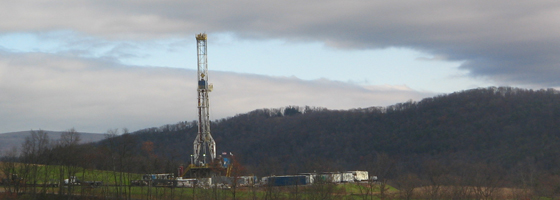A glance at the monitoring tech beneath hydraulic fracturing operations

Hydraulic fracturing is a controversial practice that extracts fossil fuels from deep shale reserves. It does so with deep holes, high pressures, sand, chemicals, water and monitoring technology.
Like water quality monitoring, hydraulic fracturing operations use sondes to study the conditions of oil and gas well boreholes. Compared with water monitoring sondes, the instruments used to analyze a borehole before fracturing shale are huge. A full suite of the instruments can stand a few stories tall. A crew of engineers and platform workers lower the assembly on a wire deep into wells to collect data.
The logging tools on the sondes come in several variations. Some use electric current, which travels from the sonde through rock and liquid. Others use gamma rays or sound waves. Each type of sonde has different measurement capabilities. The basic goal of oil and gas drillers, though, is the same. They want to see what’s going on thousands of feet into the earth.
The sondes, or electric logs as they’re known in the oil and gas industry, examine rock layers to determine which are porous and look for fluid trapped within rock layers.
Greg Kozera, an engineer, manager and author who has worked for the oil and gas industry for more than 35 years, described the sondes as an MRI for the earth. Different mineral layers and fluids absorb waves from the loggers differently, which helps identify the rocks and fluids. Oil and gas, for instance, have more electrical resistance than salt water.
Operators also monitor the drilling process with sensors attached directly to the drill to monitor rock layers, drill location, resistivity and acoustic signals.
Kozera said drilling teams analyze the mud that lubricates the drill to determine hydrocarbon content of the well. Workers also determine what they’re drilling through from rock cuttings that come up in the mud. A sensor mechanism can also be installed in-line with outgoing mud to analyze it in real-time.
Tracking where the drill travels is important, Kozera said. Drillers have to stay within in their allotted lease area and make sure the hole is in the correct orientation for hydraulic fracturing. Kozera said this is particularly important for horizontal hydraulic fracturing. Boreholes must be perpendicular to fractures to optimize the area of rock that can be fractured. This translates to a higher flow of oil and gas from rock layers.
Once workers drill the borehole and install cement and steel casings, they hydraulically fracture rock formations with millions of gallons of high pressure water, sand and chemicals. This is also monitored. Rhonda Reda, director of the Ohio Oil and Gas Energy Education Program, said workers test pressure, analyze oil and gas extraction and sometimes use down-hole cameras to look at fissures.
Both Reda and Kozera said each hydraulic fracturing operation has different geological challenges. Each well gets its own monitoring system and not all use every piece of technology available.
Environmentalists blame the process for water contamination in some areas near wells, which oil and gas companies vehemently deny. Both sides have experts and politicians backing their positions in a fact versus fiction deadlock.
One fact is certain. Monitoring technology was a big reason for the start of hydraulic fracturing in the eastern U.S.
Range Resources Geologist William Zagorski looked at well logs from Texas frackers at a conference and saw how similar Marcellus Shale formations were to Texas’ Barnett Shale, said Kozera.
The company was searching for oil and gas below layers of shale in even deeper rock layers with no success. Zagorski pitched fracking the Marcellus Shale to Range Resources president. The boom of oil and gas production in the eastern U.S. followed soon after.





Enviro Equipment Blog
November 12, 2012 at 2:21 pm
Although I try to keep up with the latest news concerning hydraulic fracturing, it wasn’t until I read your post that I realized there were so many similarities between the Marcellus and Barnett shale formations that oil/gas drilling companies would develop them pretty much same way.